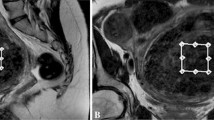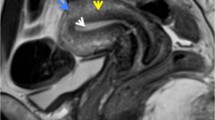Abstract
Purpose
To assess uterine contractility using ultrafast magnetic resonance imaging (cine MRI) before and after uterine fibroid embolization (UFE).
Materials and Methods
This is a prospective study of uterine contractility in 26 patients (age 30–41 years) undergoing UFE for symptomatic uterine fibroids. Cine MRI was performed before and 6 months after UFE. Two radiologists evaluated uterine contractility and classified it as absent, ordered, or disordered. Patients were then grouped into three distinct patterns of progression: unchanged contractility (group A), modified contractility (B), and loss of contractility (C). These findings were then confronted with factors that might have interfered with uterine contractility pattern (uterine volume, location of dominant fibroid, fibroid/myometrium index, and fibroid necrosis pattern).
Results
Of the 26 patients, 8 (30.7%) had no contractility before the procedure, while 18 (69.2%) exhibited some form of contractility (11 [61%] ordered, 7 [39%] disordered). All 8 patients who had no contractility at baseline exhibited contractility after UFE (5 ordered, 3 disordered). Of the 11 who had ordered contractility at baseline, 9 remained ordered and 2 lost contractility after UFE. Of the 7 with disordered contractility at baseline, 1 remained disordered, 5 progressed to ordered contractility, and 1 lost contractility. Overall, 10 patients (38%) had no change in contractility after UFE (group A), 13 (50%) had a positive change (group B), and 3 (11%) lost contractility (group C). The potential interference factors assessed had no statistically significant effect in any group.
Conclusion
In women of reproductive age with symptomatic fibroids, uterine contractility improved significantly after UFE.
Level of Evidence
Level 3—non-randomized controlled cohort/follow-up study.



Similar content being viewed by others
References
Stokes LS, Wallace MJ, Godwin RB, Kundu S, Cardella JF, Society of Interventional Radiology Standards of Practice C. Quality improvement guidelines for uterine artery embolization for symptomatic leiomyomas. J Vasc Interv Radiol JVIR. 2010;21(8):1153–63. https://doi.org/10.1016/j.jvir.2010.03.015.
Yoshino O, Hayashi T, Osuga Y, Orisaka M, Asada H, Okuda S, et al. Decreased pregnancy rate is linked to abnormal uterine peristalsis caused by intramural fibroids. Hum Reprod. 2010;25(10):2475–9. https://doi.org/10.1093/humrep/deq222.
Kunz G, Leyendecker G. Uterine peristaltic activity during the menstrual cycle: characterization, regulation, function and dysfunction. Reprod Biomed Online. 2002;4(Suppl 3):5–9.
Nakai A, Togashi K, Ueda H, Yamaoka T, Fujii S, Konishi J. Junctional zone on magnetic resonance imaging: continuous changes on ultrafast images. J Women’s Imaging. 2001;3(3):89–93.
Nakai A, Togashi K, Yamaoka T, Fujiwara T, Ueda H, Koyama T, et al. Uterine peristalsis shown on cine MR imaging using ultrafast sequence. J Magn Reson Imaging JMRI. 2003;18(6):726–33. https://doi.org/10.1002/jmri.10415.
Nakai A, Togashi K, Kosaka K, Kido A, Hiraga A, Fujiwara T, et al. Uterine peristalsis: comparison of transvaginal ultrasound and two different sequences of cine MR imaging. J Magn Reson Imaging JMRI. 2004;20(3):463–9. https://doi.org/10.1002/jmri.20140.
Kido A, Nishiura M, Togashi K, Nakai A, Fujiwara T, Kataoka ML, et al. A semiautomated technique for evaluation of uterine peristalsis. J Magn Reson Imaging JMRI. 2005;21(3):249–57. https://doi.org/10.1002/jmri.20258.
Kido A, Togashi K, Nakai A, Kataoka ML, Koyama T, Fujii S. Oral contraceptives and uterine peristalsis: evaluation with MRI. J Magn Reson Imaging JMRI. 2005;22(2):265–70. https://doi.org/10.1002/jmri.20384.
Kataoka M, Togashi K, Kido A, Nakai A, Fujiwara T, Koyama T, et al. Dysmenorrhea: evaluation with cine-mode-display MR imaging—initial experience. Radiology. 2005;235(1):124–31. https://doi.org/10.1148/radiol.2351031283.
Kido A, Togashi K, Nakai A, Kataoka M, Fujiwara T, Kataoka ML, et al. Investigation of uterine peristalsis diurnal variation. Magn Reson Imaging. 2006;24(9):1149–55. https://doi.org/10.1016/j.mri.2006.06.002.
Togashi K. Uterine contractility evaluated on cine magnetic resonance imaging. Ann N Y Acad Sci. 2007;1101:62–71. https://doi.org/10.1196/annals.1389.030.
Kido A, Togashi K, Nishino M, Miyake K, Koyama T, Fujimoto R, et al. Cine MR imaging of uterine peristalsis in patients with endometriosis. Eur Radiol. 2007;17(7):1813–9. https://doi.org/10.1007/s00330-006-0494-9.
Orisaka M, Kurokawa T, Shukunami K, Orisaka S, Fukuda MT, Shinagawa A, et al. A comparison of uterine peristalsis in women with normal uteri and uterine leiomyoma by cine magnetic resonance imaging. Eur J Obstet Gynecol Reprod Biol. 2007;135(1):111–5. https://doi.org/10.1016/j.ejogrb.2006.07.040.
Koyama T, Togashi K. Functional MR imaging of the female pelvis. J Magn Reson Imaging JMRI. 2007;25(6):1101–12. https://doi.org/10.1002/jmri.20913.
Kido A, Togashi K, Kataoka ML, Nakai A, Koyama T, Fujii S. Intrauterine devices and uterine peristalsis: evaluation with MRI. Magn Reson Imaging. 2008;26(1):54–8.
Kido A, Ascher SM, Kishimoto K, Hahn W, Jha RC, Togashi K, et al. Comparison of uterine peristalsis before and after uterine artery embolization at 3-T MRI. AJR Am J Roentgenol. 2011;196(6):1431–5. https://doi.org/10.2214/AJR.10.5349.
Leonhardt H, Gull B, Kishimoto K, Kataoka M, Nilsson L, Janson PO, et al. Uterine morphology and peristalsis in women with polycystic ovary syndrome. Acta Radiol. 2012;53(10):1195–201. https://doi.org/10.1258/ar.2012.120384.
Kido A, Ascher SM, Hahn W, Kishimoto K, Kashitani N, Jha RC, et al. 3 T MRI uterine peristalsis: comparison of symptomatic fibroid patients versus controls. Clin Radiol. 2014;69(5):468–72. https://doi.org/10.1016/j.crad.2013.12.002.
Nishino M, Togashi K, Nakai A, Hayakawa K, Kanao S, Iwasaku K, et al. Uterine contractions evaluated on cine MR imaging in patients with uterine leiomyomas. Eur J Radiol. 2005;53(1):142–6. https://doi.org/10.1016/j.ejrad.2004.01.009.
Brasil. Ministério da Saúde. Secretaria de Atenção à Saúde. Portaria No 495, de 23 setembro de 2010. 2010. http://bvsms.saude.gov.br/bvs/saudelegis/sas/2010/prt0495_23_09_2010.html. Accessed 13 Mar 2018.
Ueda H, Togashi K, Konishi I, Kataoka ML, Koyama T, Fujiwara T, et al. Unusual appearances of uterine Leiomyomas: MR imaging findings and their histopathologic backgrounds. Radiographics. 1999;19(Suppl 1):131–45.
Mas A, Tarazona M, Dasi Carrasco J, Estaca G, Cristobal I, Monleon J. Updated approaches for management of uterine fibroids. Int J Women’s Health. 2017;9:607–17. https://doi.org/10.2147/IJWH.S138982.
Williams PL, Coote JM, Watkinson AF. Pre-uterine artery embolization MRI: beyond fibroids. Cardiovasc Interv Radiol. 2011;34(6):1143–50. https://doi.org/10.1007/s00270-011-0124-z.
Bonduki CE, Baracat EC, de Lima GR, Girão MJBC. Aspectos atuais sobre tratamento do leiomioma uterino pela embolização percutânea das artérias uterinas. FEMINA. 2007;35(3):137–42.
Dariushnia SR, Nikolic B, Stokes LS, Spies JB, Society of Interventional Radiology Standards of Practice C. Quality improvement guidelines for uterine artery embolization for symptomatic leiomyomata. J Vasc Interv Radiol JVIR. 2014;25(11):1737–47. https://doi.org/10.1016/j.jvir.2014.08.029.
Siskin GP. Quality improvement guidelines for uterine artery embolization: an evolution in patient selection. J Vasc Interv Radiol JVIR. 2014;25(11):1748–9. https://doi.org/10.1016/j.jvir.2014.09.001.
Jha RC, Ascher SM, Imaoka I, Spies JB. Symptomatic fibroleiomyomata: MR imaging of the uterus before and after uterine arterial embolization. Radiology. 2000;217(1):228–35. https://doi.org/10.1148/radiology.217.1.r00se49228.
Kroencke TJ, Scheurig C, Poellinger A, Gronewold M, Hamm B. Uterine artery embolization for leiomyomas: percentage of infarction predicts clinical outcome. Radiology. 2010;255(3):834–41. https://doi.org/10.1148/radiol.10090977.
Kitamura Y, Ascher SM, Cooper C, Allison SJ, Jha RC, Flick PA, et al. Imaging manifestations of complications associated with uterine artery embolization. Radiographics. 2005;25(Suppl 1):S119–32. https://doi.org/10.1148/rg.25si055518.
Sasa H, Kaji T, Furuya K. Indications and outcomes of uterine artery embolization in patients with uterine leiomyomas. Obstet Gynecol Int. 2012;2012:920831. https://doi.org/10.1155/2012/920831.
Pelage JP, Cazejust J, Pluot E, Le Dref O, Laurent A, Spies JB, et al. Uterine fibroid vascularization and clinical relevance to uterine fibroid embolization. Radiographics. 2005;25(Suppl 1):S99–117. https://doi.org/10.1148/rg.25si055510.
Pelage JP, Le Dref O, Beregi JP, Nonent M, Robert Y, Cosson M, et al. Limited uterine artery embolization with tris-acryl gelatin microspheres for uterine fibroids. J Vasc Interv Radiol JVIR. 2003;14(1):15–20.
Carnevale FC, Messina ML, Pinto RAP, Oliva JL, Bozzini N, de Melo NR, et al. Embolização do mioma uterino solitário. Femina. 2007;35(8):493–9.
McLucas B, Voorhees WD 3rd, Elliott S. Fertility after uterine artery embolization: a review. Minim Invasive Ther Allied Technol. 2016;25(1):1–7. https://doi.org/10.3109/13645706.2015.1074082.
Mohan PP, Hamblin MH, Vogelzang RL. Uterine artery embolization and its effect on fertility. J Vasc Interv Radiol. 2013;24(7):925–30. https://doi.org/10.1016/j.jvir.2013.03.014.
Nakai A, Togashi K, Kosaka K, Kido A, Hiraga A, Fujiwara T, et al. Uterine peristalsis: comparison of transvaginal ultrasound and two different sequences of cine MR imaging. J Magn Reson Imaging. 2004;20(3):463–9. https://doi.org/10.1002/jmri.20140.
Nakai A, Togashi K, Yamaoka T, Fujiwara T, Ueda H, Koyama T, et al. Uterine peristalsis shown on cine MR imaging using ultrafast sequence. J Magn Reson Imaging. 2003;18(6):726–33. https://doi.org/10.1002/jmri.10415.
Nakai A, Togashi K, Ueda H, Yamaoka T, Fujii S, Konishi J. Junctional zone on magnetic resonance imaging: continuous changes on ultrafast images. J Women Imaging. 2001;3(3):89–93.
Kunz G, Beil D, Deininger H, Wildt L, Leyendecker G. The dynamics of rapid sperm transport through the female genital tract: evidence from vaginal sonography of uterine peristalsis and hysterosalpingoscintigraphy. Hum Reprod. 1996;11(3):627–32.
Kunz G, Beil D, Huppert P, Leyendecker G. Structural abnormalities of the uterine wall in women with endometriosis and infertility visualized by vaginal sonography and magnetic resonance imaging. Hum Reprod. 2000;15(1):76–82.
Kunz G, Beil D, Deiniger H, Einspanier A, Mall G, Leyendecker G. The uterine peristaltic pump. Normal and impeded sperm transport within the female genital tract. Adv Exp Med Biol. 1997;424:267–77.
Kunz G, Noe M, Herbertz M, Leyendecker G. Uterine peristalsis during the follicular phase of the menstrual cycle: effects of oestrogen, antioestrogen and oxytocin. Hum Reprod Update. 1998;4(5):647–54.
Author information
Authors and Affiliations
Corresponding author
Ethics declarations
Conflict of interest
The authors declare that they have no conflict of interest.
Ethical Approval
All procedures performed in studies involving human participants were in accordance with the ethical standards of the institutional and/or national research committee and with the 1964 Helsinki Declaration and its later amendments or comparable ethical standards.
Informed Consent
Informed consent was obtained from all individual participants included in the study.
Consent for Publication
For this type of study consent for publication is not required. This study was registered in the National Information System on Research Ethics Involving Human Beings (Sistema Nacional de Informação Sobre Ética em Pesquisa envolvendo Seres Humanos, SISNEP) and approved by the Research Ethics Committee/Plataforma Brasil (CAAE: 22039914.5.0000.5505).
Electronic supplementary material
Below is the link to the electronic supplementary material.
270_2018_2053_MOESM1_ESM.mov
Supplementary material—Video 1. Sagittal cine magnetic resonance (MR) images (ultrafast sequence), absence of uterine pathology showing ordered uterine peristalsis with cervico-fundal direction. (MOV 2501 kb)
270_2018_2053_MOESM2_ESM.mov
Supplementary material—Video 2. Sagittal cine magnetic resonance (MR) images (ultrafast sequence), presence diffuse submucosal myoma, of before uterine fibroid embolization (UFE) showing ordered uterine peristalsis. (MOV 1094 kb)
270_2018_2053_MOESM3_ESM.mov
Supplementary material—Video 3. Sagittal cine magnetic resonance (MR) (ultrafast sequence) images, obtained 6 months after uterine fibroid embolization (UFE), showing maintained ordered uterine peristalsis (group A—unchanged contractility pattern). (MOV 1481 kb)
270_2018_2053_MOESM4_ESM.mov
Supplementary material—Video 4. Before uterine fibroid embolization (UFE). Sagittal magnetic resonance imaging (MRI) (ultrafast sequence) showing a submucosal fibroid and absence of uterine contractility. (MOV 1941 kb)
270_2018_2053_MOESM5_ESM.mov
Supplementary material—Video 5. Sagittal cine MR images (ultrafast sequence), obtained 6 months after uterine fibroid embolization (UFE), showing new-onset ordered uterine peristalsis (group B—positive change in contractility). (MOV 1208 kb)
270_2018_2053_MOESM6_ESM.mov
Supplementary material—Video 6. Sagittal cine MR images (ultrafast sequence), obtained before uterine fibroid embolization (UFE), showing ordered uterine peristalsis. (MOV 2116 kb)
270_2018_2053_MOESM7_ESM.mov
Supplementary material—Video 7. Sagittal cine MR images (ultrafast sequence), obtained 6 months after uterine fibroid embolization (UFE), showing absence of uterine contractility (group C—loss of contractility). (MOV 1669 kb)
Rights and permissions
About this article
Cite this article
Fornazari, V.A.V., Szejnfeld, D., Szejnfeld, J. et al. Evaluation of Uterine Contractility by Magnetic Resonance Imaging in Women Undergoing Embolization of Uterine Fibroids. Cardiovasc Intervent Radiol 42, 186–194 (2019). https://doi.org/10.1007/s00270-018-2053-6
Received:
Accepted:
Published:
Issue Date:
DOI: https://doi.org/10.1007/s00270-018-2053-6




